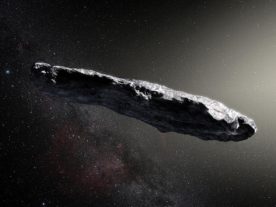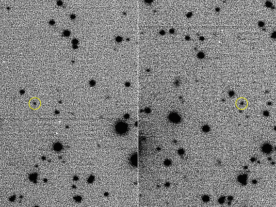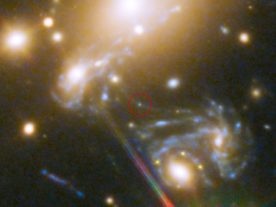
Oumuamua: It’s a Comet, It’s an Asteroid, No, wait, It’s a Comet
An odd rocky cigar-shaped object called Oumuamua made news late last year when it was determined to be of interstellar origin. It was touted as the solar system’s first visitor from another star system. Some scientists first pegged Oumuamua as a comet soon after its discovery. A few months later studies indicated that it was […]

Asteroid May Have Immigrated From Another Solar System to Ours
An odd cigar-shaped object name Oumuamua made news late last year when it was determined to be of interstellar origin. It was touted as the solar system’s first visitor from another star system. A new study published in Monthly Notices of the Royal Astronomical Society: Letters details the discovery of what scientists are calling the […]

Discovered: Most Distant Star Seen (So Far)
The 2016 discovery of the most distant star ever seen – so far – has been outlined in a new study published in the journal Nature Astronomy. According to the study, the star, formally named 1) but nicknamed Icarus, is located about 9 billion light-years from Earth. This means light from the star started toward […]

Astronomers Find Newborn Stars Near Supermassive Black Hole
A star being consumed by a black hole may seem quite common. But, news of stars being formed alongside a black hole could be something to notice! But that’s just what a UK-led group of astronomers say they recently discovered. While they were studying the ongoing collision of two galaxies, known jointly as IRAS F23128-5919, […]

Happy 26th Birthday Hubble Space Telescope!
Sunday, April 24, 2016 will mark the 26th anniversary of the launch of the Hubble Space Telescope aboard the space shuttle Discovery mission STS-31. It was deployed from the shuttle’s payload bay the following day, April 25, 1990 Over its 26 years of service Hubble’s numerous discoveries and the breath-taking and detailed images it has […]
NASA Creates New Office to Protect Us from Asteroid and Comet Impact
NASA is taking the potential threat posed by near earth objects (NEO’s), such as asteroids and comets, more seriously than ever and has established the new Planetary Defense Coordination Office (PDCO). The space agency says the new office will oversee all of its efforts in finding and characterizing all celestial objects that travel close to […]

Astronomers Find Massive Star Making Galaxy Cluster
Astronomers have discovered a distant and massive galaxy cluster with a gigantic and prolific galaxy at its heart that’s pumping out hundreds of stars each year. The galaxy cluster is named SpARCS 1049+56 and is located about 9.8 billion light years from Earth in the Ursa Major constellation. Galaxy clusters are areas of the universe […]
Scientists Find Jupiter’s Younger Sibling
A group of scientists have discovered a new exoplanet they say resembles a young Jupiter. Called 51 Eridani b, the gas giant is about 100 light years away, has twice the mass of Jupiter, orbits its star – 51 Eridani – at a distance comparable to between Saturn and Uranus in our solar system and […]
Science Images of the Month – November, 2014
Unique Carbon-Based Molecule Found in Deep Space May Indicate Origins of Life
Astronomers from Cornell University in Ithaca, NY, Germany’s Max Planck Institute for Radio Astronomy, and the University of Cologne found an unusual carbon-based molecule called isopropyl cyanide in a gas cloud some 27,000 light years away. Those involved with the discovery say the finding suggests the type of complex molecules needed for life may have […]
